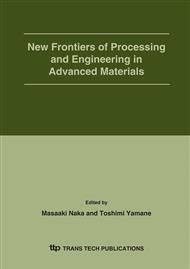p.81
p.87
p.95
p.99
p.105
p.111
p.117
p.123
p.129
Interfacial Structure and Strength of Ceramic/Metal Couples
Abstract:
SiC reacts with metals at high temperatures, and forms metal carbide, metal silicide and metal carbosilicide depending on metal. The interface structure is formed by the diffusion path between SiC and metal. The diffusion path between SiC and metal is described on the tie-lines of the corresponding M-Si-C (M:Metal) ternary phase diagram. The interfacial strength of SiC/Metal depends on the thickness of reaction zones at SiC/Metal couple. Although the increase of thickness of reaction zone improves the interfacial strength of SiC/Metal couple, the increase of internal stress and crack in the reaction zone degrades the strength of the couple. The interfacial strength of SiC/Metal couple yields the maximum at a thickness of reaction zone.
Info:
Periodical:
Pages:
105-110
Citation:
Online since:
December 2005
Authors:
Price:
Сopyright:
© 2005 Trans Tech Publications Ltd. All Rights Reserved
Share:
Citation:


